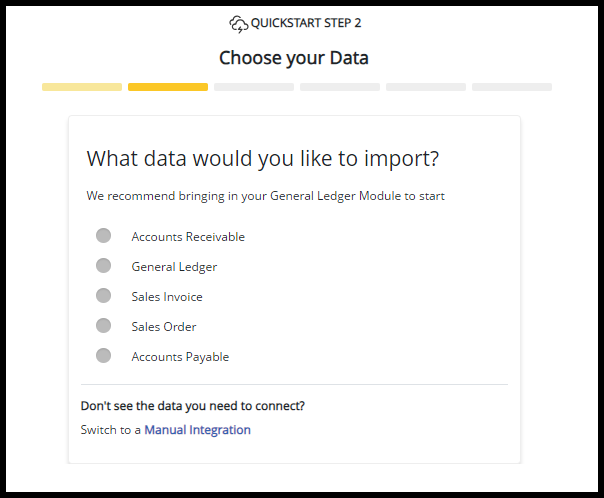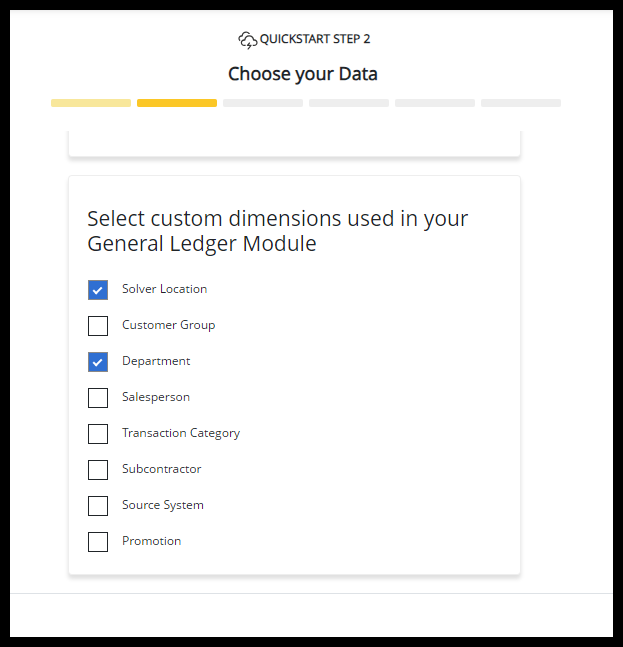This article discusses how to configure a QuickStart integration for Business Central V2 in Solver and details on the connector.
Overview
This article will detail the steps to set up and configure QuickStart for Business Central which is sometimes referred to in this document as “QS”. QuickStart is a wizard-driven process made to assist you in quickly setting up an integration and reports from your organization’s Business Central implementation to Solver Cloud.
Before using QuickStart for Business Central, there are a few items to be aware of:
- QuickStart for Business Central is only supported for Business Central V2 Cloud to Solver Cloud customers. If you are hosting Business Central and/or Solver Private Host on-premise, QuickStart is not supported.
- QuickStart is available to new implementations only, at this time.
- Please disable popup blocking for the Solver Cloud site via your browser settings. This is needed in order to display the authentication screen.
QuickStart for Business Central will give you out-of-the-box integrations to the General Ledger and more, as documented here. In addition, you can connect to additional, BC-supported endpoints as documented here.
This QuickStart implementation will allow for rapid data integrations from Business Central into your Solver tenant. With this method, users will be able to integrate the most common financial data, with the ability to integrate business-specific data, in a couple of clicks for their reporting and budgeting needs.
Users should note that the basic QuickStart integration from BC that this guide has highlighted requires specific data brought in. This data is the minimum required components for a QuickStart using BC. For more information on the particular data available for this implementation, please reference this article on QuickStart features.
Pre-Configuration
Before beginning a QuickStart for Business Central integration, there are several steps that users must follow in order to ensure that their data will be imported into Solver. This section will describe these steps and link to other important knowledge-based articles with information on how to ensure the validity of the connection between BC and Solver.
The following section details the process of adding a Solver connection to the Business Central ERP.
This process must be followed in order to create an integration between the two programs successfully. Each user must follow these steps when setting up their permissions for the first time and these permissions can be edited at any time but any changes on the Business Central side require a new integration to be set up and run in order to use this data in Solver.
For directions on how to configure your Business Central account to integrate with Solver, follow the steps documented below about Business Central.
To use QuickStart with Business Central, users must:
- Be a Solver Cloud AND Business Central Cloud Customer.
- Allow popups in your browser. This is required because you must sign into your BC tenant via a Microsoft login popup during the configuration process of the BC integration.
- Data permissions are based on the account’s permissions in Business Central. It is recommended to use an account with full data access to ensure a seamless data load process.
- Log in to Business Central using your account’s profile with administrative permissions.
- These changes must be made from the admin profile in order to connect to Solver and use Quick Start.
- Select the appropriate account from the login screen and enter the password for this account.
- Once logged in, follow the steps found in this article to download the Solver extension for Business Central and activate the extension within Business Central.
- Following the setup of the extension, you will need to configure the account categories that you will be using with Solver in order to complete your QS integration.

- Select the search button and type account categories into the box and click on “G/L Account Categories”.
- See Business Central documentation for instructions on configuring account categories for your implementation.
QuickStart Setup Guide
Before using a QuickStart for Business Central, you must create periods in the Data Warehouse if you have not already. Follow these steps to create your Financial Calendar in Data Warehouse. You will need to create, at a minimum, the prior year and current fiscal year with the Data Warehouse. Once this process is complete, you may begin your QuickStart integration.
To create a QuickStart integration:
- Navigate to the DW.
- Select the Data sub-menu.
- Click Integrations.
- Select the Add New button from the upper right-hand corner of this screen to open the connector marketplace.
- Select the BCv2 icon.
- Click the Create QuickStart button.

- Once the Wizard begins, click Authenticate to begin the login process.
As mentioned above, make sure that popup blockers have been disabled in your browser’s settings for the Solver Cloud site.
- Within the Microsoft Authentication pop-up window, type in (or choose) your account information.

- Select the Module data that you would like to use for your integration.

- Choose any custom dimensions to use in their GL module.

- Map your categories using the next screen which shows a hierarchal view of a balance sheet and income statement report in the main grid.
For more information on how to use the Category Mapping page, see our article detailing this page here.
- Complete this exercise for all account categories in use. It is strongly recommended by Solver that users do the account category mapping exercise. By completing the account category mapping exercise, users get access to the Template Marketplace where “ready to use” reports are available for download.
- Upload budget data from BC using one of the several options of the version of budget data.

It is recommended to use the most recent budget data for optimal results. - Create a job to run the integration by selecting from the options on the next page in the wizard.
- Set up a name, runtimes, and frequency of the integration job as well as an email(s) for users who should receive integration status emails.

- Set up a name, runtimes, and frequency of the integration job as well as an email(s) for users who should receive integration status emails.
- Click Run to finalize your configuration and the data load process will begin.

This completes the process for setting up a QuickStart for Business Central.
More information
Integrations
- A dimension integration loading in your chart of accounts and all selected dimensions.
- A GL Detail Integration
- An Opening Balance Integration
- Accounts that have a beginning balance of $0 have been excluded by default. You can modify this integration to include $0 opening balance accounts.
- Opening balance is only at the account level. It does not include any additional dimension information.
Rules
- Generate GL Summary Data: this rule will generate GL Summary data from the GL Detail data for Actuals only.
- PopulateStargate: this rule will update all transactions with the appropriate Stargate value necessary for the Template Marketplace reports to work.
Job
- General Ledger Data Load (non-recurring): this job includes all the above integrations and rules as mentioned above loading in last year all to the current period worth of data. This job contains an opening balance data load and has been set to non-recurring since the opening balance does not need to be loaded in often.
- General Ledger Data Load (recurring): this job includes all the above integrations and rules except for the opening balance integration. This has been removed from this job to reduce the number of transactions being imported for faster data loads.